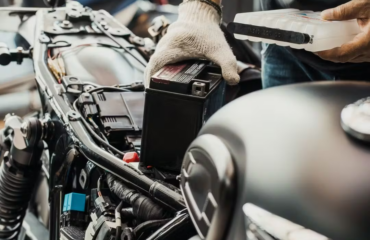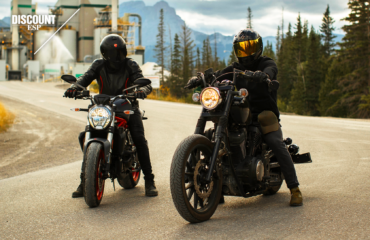
Whether owning a motorcycle has been a lifelong dream or a desire recently born from long-term lockdowns, there’s a lot to think about. If you’ve never ridden before, you can’t just show up at the dealer on a whim, sign the contract, and ride it home. Along with the exhilaration of researching and selecting your first bike, there is the humdrum of preparing to own a motorcycle. Here’s what you need to do!
Take rider training and get your license
Find and take a Basic Rider Course (BRC) near you. The Motorcycle Safety Foundation has a searchable directory by zip code. In most states, it will waive the on-road test for the license.
Check the requirements of your course to see what gear is required. For example, “You will need a DOT-approved helmet (LCMS does not allow “half helmets,” 3/4 or full-face only), eye protection, full-fingered gloves, sturdy long pants, a heavy-duty long sleeve top or jacket, and over-the-ankle boots. (minimum height of boots, needs to cover the ankle bones).”
We talk more about gear in “Clothing and Safety” below. It’s worth spending some extra time to get the gear you want right at the beginning rather than settling for meeting the basic standards of your training class.
Once you’ve passed the BRC, take a look at one of the Advanced Rider Courses. These courses consist of activities that emphasize personal risk management, self-assessment strategies, and on-cycle exercises with an emphasis on cornering, braking, and swerving. At WCTC in Wisconsin, there are two advanced classes: the BRC2, which trains at higher speeds on your own bike, and the Ultimate Bike Bonding Rider Course, which is patterned after police motorcycle training.
Be mindful of local laws
Motorcycle riding requirements are different in every state. Some require helmets while others don’t, and in some states, it depends on your age. States also have different rules about things, such as eye protection, noise restriction, lane splitting, mirrors, and passengers. The Motorcycle Legal Foundation has a comprehensive list on its website. We recommend that you check it out.
To register your bike, you’ll need the title, proof of insurance, a motorcycle license (which you can get either with a road test or by passing a BRC), and an emissions test, unless you live in AZ, CA, MD, MO, OH, UT, or VA.
Wear proper clothing and safety gear
Experienced riders will almost always tell you not to worry about looking cool. You want to be safe and comfortable first. You’ll want to invest some time into choosing a helmet, eyewear, a jacket, gloves, boots, and pants. Each of these protects your soft insides in an accident.
Helmet: Full face coverage gives you protection against injury, asphalt, and bugs. The most important thing is to make sure it fits properly, which is tighter and snugger than you would expect. For your first helmet, it’s a good idea to buy it in person to assure a proper fit. Some states require a DOT-approved helmet so check the laws where you live. If your helmet has a visor, it shouldn’t fog up.
Jacket: Your jacket needs to protect your shoulders, forearms, and elbows while helping you maintain a comfortable body temperature. They are available in either textile or leather. Generally, leather is more abrasion-resistant at the expense of being heavy and hot to wear, while textile sacrifices some impact resistance for waterproofness and comfort.
Gloves: Here the choice is between protection and freedom of movement. Since your instinct is to protect yourself with your hands when you fall, err on the side of protection.
Boots: Your boots need to provide ankle support and protection, while allowing you to work the foot controls. If possible, test them out before purchasing.
Pants: Jeans are the worst choice because they will shred on the pavement in an accident. Leather is best for the same reason it works well in a jacket. Look for something with armor in the knee, hip, and tailbone.
Finally, motorcycle eyewear is designed to protect your eyes in a way that standard eyewear doesn’t. Goggles or glasses made for the open road will shield your eyes from dust, debris, and wind, as well as protect you if you take a spill.
Check your mechanics before you ride
One of the worst things is having a mechanical breakdown during a ride, especially if you’re not able to get out on the road as often as you like. Whether the bike is used or brand new, you need to inspect it before each ride. Give it a high-level look to make sure everything is as it should be. Then check the tires, battery, lights, controls (grips, levers, cables, hoses), fluids, brakes, and chain or belt. Finally, test the turn signals, and adjust your mirrors.
Tips for getting your first bike home
If this is the very first motorcycle you’ve ever owned, you might want to figure out another way of getting it home than riding it yourself. You can always have it delivered from the dealership, rent a U-Haul trailer, or bring a more experienced friend along to transport it.
If you’re absolutely certain that you want to ride it off the lot yourself, make sure that you:
- Have your license and registration with you.
- Bring along your helmet and other protective gear.
- Inspect the bike and adjust the mirrors before riding.
- Take it for a test drive around the parking lot before taking it to the streets.
- Travel when traffic is light.
Purchase bike protection
Your motorcycle insurance covers your financial losses in the event of an accident or theft. An extended service plan (ESP) is a different type of coverage that protects you from costly repairs that aren’t included in either the manufacturer’s warranty or your insurance policy.
In both cases, the coverage protects you against expensive, unforeseen bills. With insurance, you don’t have to worry about accidents. With an extended service plan, you don’t have to worry about major repairs. While an ESP is not required by law, it’s a wise investment.
Make sure to get covered by Discount ESP before you slide on your helmet and hit the road.





